Allison V-3420-9 Type Test
Compiled by Kimble D. McCutcheon
Published 1 Jul 2024
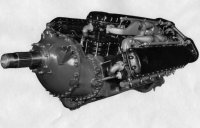
Allison V-3420-9 |
The Army Air Corps had begun to develop strategic plans for long-range bombers by mid-1930, plans that informed the need for extremely large bombers capable of carrying enormous bomb loads for tens-of-thousands of miles. These bombers would require enormous engines, ones that were far beyond the mid-1930s state-of-the-art. Emerging air-cooled engines were at that time incapable of providing the needed power.
The majority of this article is excerpted from the 9 Jul 1942 Memorandum Report EXP-M-57-503-663, Type Test of V-3420-9, covered under U.S. Army Air Corps Purchase Order No. 503-1-435. Some sections are amplified by excerpts from other reports, which are indicated with their own Memorandum Report references.
|
Background
In April 1934 the U.S. Army Air Corps issued a request for "Long range Airplane Suitable for Military Purpose," the XBLR (eXperimental Bomber, Long Range). The respondents' aircraft designs, based on the Allison V-1710, were hopelessly underpowered. The U.S. Army Air Corps began toying with the idea of a doubled-up Allison V-1710, the Allison XV-3420 (Restricted Project M-2-35) as a candidate for long-range heavy bomber projects. The Air Corps was hoping for a 2,000 hp engine, which was optimistic for the mid-1930s. Wanting an engine that was as light as possible, The Army strongly suggested to Allison a single-crankshaft 24-cylinder engine based on V-1710 cylinder blocks. This would have required master rods with three articulated rods for each cylinder row, a scheme that would have limited rpm to 2,400 and output to 1,600 hp. Allison rejected this construction, and began exploring alternative layouts for a 2,000 hp engine at its own expense.[Whitney, Daniel D. Vee's For Victory: The Story of the Allison V-1710 Aircraft Engine, 1929 – 1948. (Altglen, PA: Schiffer Military History, 1998). 282]
On 11 Jun 1935 Allison engineers Norman H. Gilman and Harold Caminez met with Engineering Division Power Plant Laboratory Chief Maj Edward M. Powers and civilian employees Opie Chenoweth, Ford Prescott and C.E. Mines. Gilman presented installation and assembly drawings for a proposed XV-3420, and agreed to submit informal quotations for a single XV-3420-1 with a single propeller geared 2:1, a single XV-3420-3 with a contrarotating propeller geared 2:1, and a reduction gear assembly that would convert the XV-3420-1 into a XV-3420-3.[17 Jun 1935 Memorandum Report E-57-861-1. Conference with Representatives of Allison Engineering Company on Allison X-3420 Type Engine, June 11 1935. Record Group 342 P042419]
The next day, 12 June, Allison issued Specification 201, which was a single-crankshaft XV-3420-1 engine that used articulated connecting rods attached to a single master rod in each cylinder row. Allison claimed the XV-3420-1 would produce 1,600 hp and weigh 2,160 lb or less. It would be equipped with a 10" supercharger impeller driven at seven times crankshaft speed. The 2.0:1 propeller reduction gear would drive a SAE No. 50 propeller shaft. The compression ratio was to be 8.5:1, a value that would presumably produce favorable specific fuel consumption. A Marvel MC-12 fuel injection system was to deliver 100 octane fuel to the individual cylinders, producing 1,000 hp at 1,800 cruising rpm and 0.42 lb/hp/hr specific fuel consumption. Unfortunately, Marvel never got the fuel injection system to work.
During March 1936, Ron Hazen became Allison's chief engineer and was immediately confronted with too many concurrent projects that spread his development team too thin. On 4 Nov 1936, Hazen directed his design team to prepare a quotation to the Air Corps for the design and fabrication of one engine and 50 hours of development testing. This engine was to have two crankshafts geared together, four V-1710 cylinder banks and have a 2,000 hp normal rating and a 2,300 hp takeoff rating. Either single or contrarotating propellers could be accommodated by changing the nose case. The engine was to be reversible by changing a minimum number of parts and was also to use as many V-1710 parts as possible. XV-3420-1 development limped along, the victim of Allison over-extension and Air Corps bureaucratic foot-dragging. It finally passed a 50-hr endurance test in March 1940, along with a 150-hr type test at a later date. However, it never powered an airplane, but served as the baseline upon which other V-3420 models were built.
In February 1941, the Air Corps requested that Allison design a 3,000 hp engine as a standby engine for Boeing B-29s in case Wright R-3350 engine development was protracted. The installation was to be interchangeable with the R-3350. The Air Corps ordered one V-3420-9 (Allison V-3420 A11R). This became available during June 1941 and is the subject of this article. [Whitney, 283-288] As it turned out, Wright finally got the R-3350 into production and the V-3420-9, despite passing a type test, never powered an airplane or reached serial production. On 100/130 PN fuel, it was takeoff rated 2,300 hp at 3,000 rpm and normal rated 2,000 hp at 2,600 rpm. It had a 1:6.82 supercharger impeller ratio and a 2.5:1 reduction gear ratio driving an SAE No. 50 propeller hub.
Allison V-3420-9
 |
 |
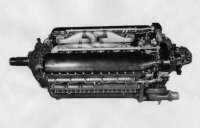 |
 |
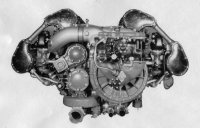 |
 |
| V-3420-9 Walk Around |
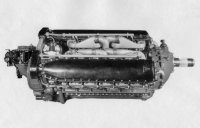 |
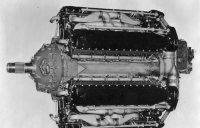 |
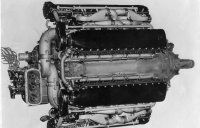 |
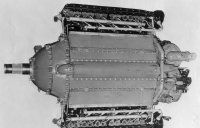 |
 |
|
| V-3420-9 Walk Around |
V-3420-9 Top |
V-3420-9 Bottom |
|
Type Test Summary
This report covered the Allison V-3420-9 engine, Army Air Forces No. 41-50951, Mfg. No. 5425 type test in accordance with Specification AN-9502a. This test was run at Wright Field, Dayton, Ohio, between 12 Feb 1942 and 16 Jun 1942. At 75:30 hours official endurance time, the engine left rear reduction gear pinion bearing failed, halting the test. The engine was rebuilt at the General Motors Allison Division, and returned to Wright Field for continuation of the test. The engine completed the 150-hour endurance test and 75:30 hour penalty run without major incident. However, considerable difficulty was experienced with spark plug fouling, necessitating frequent replacements. After test completion, tear-down inspection revealed no major engine defects.
It was concluded that the V-3420-9 satisfactorily completed the 150-hour type test in accordance with Specification AN-9502a.
Recommendations
- Materiel Center letter dated 6 Jul 1942 granted the General Motors Allison Division type approval on the V-3240 engine.
- However, it was further recommended, that the Allison Division expedite and continue development work on distribution and spark plug performance as definite improvements in these areas were considered essential prior to V-3420 use in aircraft.
Process
The V-3420-9 engine was calibrated on Dynamometer Stand No. 11 and endurance-run on Torque Stand No. 3 at Wright Field. After 75:30 hours, the engine failed to scavenge, and the oil pressure out of the engine built up considerably beyond normal operating pressure. The engine was removed from the stand and returned to the Allison Division for disassembly inspection to determine the failure's cause and extent.[EXP-M-57-503-663]
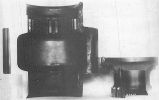 |
| Left Pinion and Coupling |
The following defects were found:
- There were two small cracks in the center crankcase Nos. 5 and 6 webs around the bearing bolt bosses.
- The left front and left rear pinion bearings, PN 35475, had failed.
- The left reduction gear pinion, PN 40206, was cracked.
- The left inner coupling, PN 41827, and outer coupling, PN 41851, had failed.
- The left bearing cage ,PN 40222, was cracked.
- The reduction gear housing had several fine radial cracks through the front pinion bearing boss, apparently the result of the bearing failure. Another engine under test at Allison had similar pinion and pinion bearing failures.
- The left crankshaft drive plate that engaged the left pinion coupling had a crack in the splines.
- The supercharger drive gear bushing, PN 40906, was lightly scored.
- The starter shaft oil seal, PN 35308, was charred sufficiently to require replacement.
- The starter shaft spacer, PN 35315, was slightly worn.
- The propeller shaft rear bearing washer, PN 35436, was scored on one clamped surface.
- Nos. 4 RC (front), 5L (front), and 5L (rear) exhaust valves, PN 33920, were slightly guttered.
- The No. 4 RC (rear) intake valve was not seating properly.
- There was excessive pick-up on the rod bearing half parting surfaces, especially No. 5.
- There was excessive pick-up on the rod bearing outsides where the forked rod clamped around the bearing.
- The coolant riser tube from the coolant pump to the cylinder banks had cracked in the weld.
- The propeller governor drive shaft, PN 35073, and bushing, PN 35074, were damaged during preliminary disassembly at Wright Field.
The engine was rebuilt for continuation of the type test using the following new parts:
- Two new nitrided crankshafts, PN 41309, were installed to obtain type test approval of the nitrided shafts.
- All main bearings were changed to obtain proper clearances with the new crankshafts.
- The center crankcase was replaced with a crankcase of the same design but cast by the Antioch founding process instead of the Alcoa method. (Note. In the Antioch casting process, 50% plaster of Paris and 50% sand is mixed with water. The mixture is poured over the casting pattern and let set. The pattern is then removed, the mold placed in an oven and subjected to hot steam under high pressure, and then air dried. The Alcoa method is traditional sand casting.)
- An improved rear reduction gear case, PN 40222DD, cast at Antioch, was used to replace the PN 40222S case that had been damaged by the bearing and pinion failures. This new design featured extended top ribs and additional ribs near where the failure occurred.
- Supercharger drive gear bushing, PN 40906.
- The supercharger impeller rotating guide vane thickness was increased from 0.084" to 0.094"
- Starter shaft oil seal, PN 35308.
- All four bronze pinion bearings, PN 35475 were replaced with lead-coated silver bearings, PN EX1216.
- Bearing cage, PN 35496, on left side only.
- Outer coupling, PN 41851, and inner coupling, PN 41827, on left side only. The new coupling designed was machined from forgings rather than from bar stock.
- Cylinder Nos. 4 RC (front), 5L (front), and 5L (rear) exhaust valves, PN 33920.
- Left hand pinion, PN 50206.
- Governor drive shaft, PN 35073, and bushing, PN 35074.
- Starter shaft spacer, PN 35315.
- Propeller shaft rear bearing washer, PN 35436.
- Supercharger driving gear, PN 40910, was replaced because of excessive taper on the journal.
- The coolant riser tube was replaced with a new design made from mild steel with a 0.063" wall thickness.
- The coolant pump body was replaced by a new design with reinforcing fins and different heat treat.
- Four studs, PN 35024-C, in rear reduction gear case were replaced with PN 35024-G to provide a stiffer stud.
- Cylinder No. 4 No. 5 oil ring, PN 33840.
- Four distributor shaft oil seals, PN 40680, and four distributor drive packings, PN 18824 were replaced. Two ignition cable cross tubes, PN 41476, were changed because of damaged shielding. Cylinder No. 6L intake, Nos. 2L, 5L and 4R exhaust spark plugs were replaced. The left side intake ignition cable tube assembly, PN 41479, was replaced because of a failed bellows.
[12 Mar 1942 Memorandum Report EXP-M-57-503-563. Visit to Allison Division on Teardown Inspection of V-3420-9 Engine, Air Corps No. 41-50951. RG342 P192296]
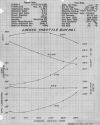 |
| Power Curves |
On 7 Apr 1942, the engine was returned to Wright field and reinstalled on Torque Stand No. 3 for continuation of the type test from 75:30 hours. On 25 May 1942, the engine completed the period from 75:30 hours through the 150 hours and dive speed runs. It was then removed for disassembly inspection, which revealed the following:
- Two supercharger oil seal retainer bolts had failed in tension in the thread at the nut base, which had allowed oil leakage through the supercharger and into the manifolds.
- Steel slivers were found on top of governor drive upper bushing. It was assumed that these steel slivers came from the propeller governor.
- A high tension lead terminal in the left magneto fell off during disassembly, indicating that it had been loose during operation,
- The coolant pump inlet elbow was scraped either by a particle passing through or from impeller contact.
- The oil-out elbow and coolant pump cross-over tee were rubbing against each other and were badly worn.
- There was a considerable number of bronze particles in connecting rod and main bearings. No. 6 connecting rod bearing had an eroded valley about 0.5", long and 0.016", wide near the oil hole. Practically all connecting rod bearings showed galling on steel shell parting surfaces.
- Scavenger pump drive gear teeth were badly pitted.
- Both inner camshaft drive gears, PN 35150, were galled.
- Camshaft center drive gear, PN 35390, beveled gear teeth were galled.
- Crankshaft inner and outer coupling spline teeth were slightly galled
- Oil pump drive and starter shaft gear teeth were slightly galled.
- One tooth on camshaft upper drive shaft gear, PN 35160, was slightly pitted.
- The propeller shaft lock nut face was badly scored.
- Cylinder No. 3R exhaust valve, No. 33920, was slightly guttered.
The engine was reassembled with only one part replaced— the No. 3R exhaust valve, was replaced with a new PN 33920 valve. The engine was returned to the torque stand for the 75:30 hour penalty run. On 16 Jun 1942, the 75:30 hour penalty run was competed, and the engine disassembled for inspection, which revealed the following:
- Cylinder No. 4RC valve tappet clearance was 0.043".
- The coolant pump cross-over tube and oil outlet elbow were practically worn through from the interference that had been noted at the 150-hour teardown inspection.
- Cylinder No. 5L (rear) exhaust valve showed evidence of blowby; this valve was replaced at 75:30 hours.
- There were signs of pick-up on the starter shaft journal.
- The bevel gear teeth on both camshaft inner drive shafts, PN 35149, were slightly pitted.
- The gear teeth on both camshaft upper drive shaft gears, PN 35159, were pitted.
- There was pick-up on both faces of vacuum pump drive idler gear, PN 35171 and matching spacer.
- Gear teeth were pitted on both inner camshaft drive gears, PN 35150.
- The bevel gear on the camshaft center drive idler gear, PN 35390, was badly pitted.
- Bevel gear teeth on pump drive and starter shaft, No. 35037, were slightly pitted.
- Spline teeth on left and right inner and outer couplings were slightly galled.
- The seals in camshaft lower drive housing center, PN 35141, RC and LC had two helical cuts. This probably occurred during disassembly.
- The front scavenger pump drive gear was worn considerably more than at 150 hours.
- The generator drive oil seal was charred.
- The crankshaft supercharger drive gear, PN 35998, showed pick-up on beveled face and on matching spacer face.
- The No. 6 left upper main bearing half was badly eroded in half of the oil groove, and the eroded metal had piled up in the other half of the oil groove. Main bearings 6 right lower, 2 right lower, 7 right upper, along with connecting rod bearings 6 left and 3 left had small erosion spots. All connecting rod bearings evidenced the same galling on steel shell parting surfaces that was noted during the 150-hour teardown, but to a more marked degree.
- Cylinder No. 5 RC exhaust valve adjusting screw ball was stuck with carbon.
- Cylinder 4 LC piston top compression ring was stuck.
- One tachometer drive gear was very badly worn.
- The fuel dye pattern on the supercharger impeller indicated that fuel had apparently been admitted from the center nut in addition to the ejection holes midway along the impeller blades. This may have been one cause of the poor distribution experienced.
- The propeller shaft rear hearing nut was scraped more than at 150 hours, and also showed signs of pick-up.
- The pinion journals and crankshaft main journals were scored to a greater degree than the nitrided steel journals of V-1710 engines recently run at the Materiel Center.
- The connecting rod bearing steel shell parting surfaces were badly galled.
The Materiel Center inspectors deemed that none of the unsatisfactory items discovered in the latter two disassembly inspections was of major importance, and that the major items were satisfactory. However, mention was made that 43 spark plugs were replaced during the tests, not counting the complete sets of new plugs installed after 75:30 hour of endurance test time and 28:30 hours penalty tune. This condition was considered highly undesirable, and definite improvement was required before the V-3420 would be suitable for flight use. Mixture distribution was very poor and was a major cause for plug fouling. In addition, Materiel Center criticized the exhaust plug location because it rested in a pocket directly opposite the intake port, which allowed all solid particles to gather in the pocket and foul the exhaust plug.
In addition to the foregoing difficulties, some trouble was experienced with the ignition system during the test. At 141:30 hours it was necessary to replace a sheared timing pin in the right center distributor. This was the same difficulty experienced during the 150:00 hour penalty test at 146:00 hours during the higher rating test accomplished at the Allison Division. Also, on two different occasions, at 141:45 hour endurance time and at 28:30 hours penalty time, it was found that the high tension terminal in the magneto had broken loose, causing the distributor to malfunction.
At 66 hour penalty time, some trouble was experienced with scavenging. The entire oil system, engine and stand, was inspected and no unusual conditions were found. No explanation has as yet been found for this trouble.
Nevertheless, with the exception, of the spark plugs and distribution, the V-3420-9 engine was considered to have completed the type test and penalty test in a very clean condition, and it was understood that the Allison Division had initiated improvements. The mixture distribution problem still remained a major item requiring further development.[EXP-M-57-503-663]
Mixture Distribution Fixes
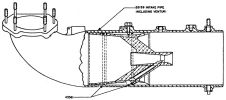 |
| Manifold duct with PN 53139 Venturi Assembly |
On 27 Aug 1942, Allison representatives met with Power Plant Laboratory personnel at the Power Plant Laboratory to discuss Allison's plans for addressing the V-3420 mixture distribution anomalies. At the completion of its 150-hour type test, the V-3420-9 engine, A.F. No. 41-50951 had been reassembled with a 6.9:1 supercharger drive ratio replacing the 6.0:1 ratio that had been installed during the test. In addition, streamlined manifolds were installed in place of the standard parts that incorporated tee backfire screens.
Allison pointed out two categories of distribution anomalies: distribution between the two basic V-1710 engines that comprised the V-3420 and distribution within each V-1710 engine. The manifolds that were being shipped to the Materiel Center were intended to improve distribution within each V-1710 by picking any liquid fuel that accumulated on the manifold walls through the use of a venturi inside the manifold passages. An improved supercharger oil seal was also furnished to reduce spark plug fouling at low speeds. The streamlined manifolds had eliminated the use of backfire screens, which removed the problem of backfire screen clogging, a phenomenon exacerbated by oil in the manifolds.
Allison planned to address the distribution between the two V-1710s by dividing the cross-over tee at the supercharger exit into four ducts instead of the two ducts of the original design. Each cross-over manifold would then receive its mixture from alternate cross-over tee positions. This meant that each manifold received a portion of its mixture from the leaner side of the cross-over tee and another portion from the richer side. Several other schemes had been considered, but all restricted the manifolds in some way, resulting in a trade off between manifold restriction and mixture quality. [3 Sep 1942 Memorandum Report EXP-M-57-503-704. Conference on V-3420 Distribution Studies. RG342 P193016.]
Timing Tests
 |
Timing Tests
Results |
Between 16 Jan 1943 and 7 Jun 1943, Allison V-3420-9 AAF No. 41-50951 was again pressed into service at Wright Field for a timing test series. The cylinder blocks were fitted with special spark plug bushings that located the plugs 0.375" nearer the cylinder centers in an effort to determine the effect on power output and spark plug performance. Sea level calibration runs at various spark timings were made to identify optimum timing. With intake and exhaust plugs fired simultaneously this was 30° BTC. Dynamometer failure terminated the tests before work on staggered timing could be completed. Additionally, a crack was discovered in the crankcase near the right front mounting pad, which resulted in permanent test termination for this engine. Some spark plug fouling was encountered, due primarily to a leaky supercharger drive shaft oil seal. Fouling was most frequent in the left and right bank exhaust plugs.
The test engineers concluded that with service fuels then available, maximum power was produced at 2,800 rpm with simultaneous ignition timing set between 25° and 30° BTC. Spark plug fouling was not eliminated by spark plug relocation. The engineers recommended further testing with staggered ignition timing, a thorough investigation of spark plug fouling and consideration of variable ignition timing.
As tested with a 5.5" bore, 6.0" stroke, 3,421.19 in³ displacement and 6.65:1 compression ratio, the V-3420-9 had a 2,000 hp at 2,600 rpm normal rating and a 2,300 hp at 2,800 rpm takeoff and military rating. The supercharger gear ratio was 6.0:1, the impeller diameter 10.0", and the reduction gear ratio 2.5:1. Propeller shaft size was SAE No. 60, propeller rotation right-hand tractor, and weight was 2,460 lb. two Scintilla DFLN-6 magnetos and a Bendix PT13E1 carburetor were used. The coolant was ethylene glycol and both crankshafts rotated in the same direction.
Tests were conducted with both intake and exhaust timing both at 15, 20, 25, 30 and 35° BTC, and also 28°/16° and 28°/22° intake/exhaust. Early test termination prevented testing at other ignition settings. The tests that did occur were similar to full-throttle sea-level calibration runs, with speeds from 1,600 rpm to 2,800 rpm and full-rich mixture.[26 Jan 1944 Memorandum Report ENG-57-503-1142. Ignition Timing Study on Allison V-3420-9 Engine, AAF No. 41-50951. RG342 P280980]














